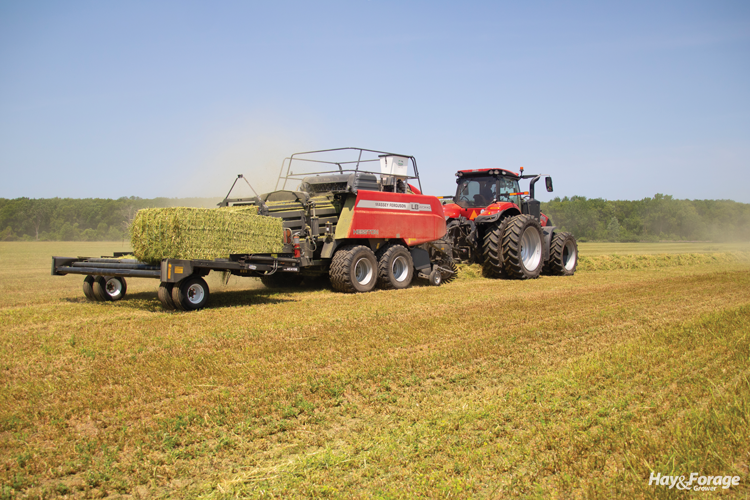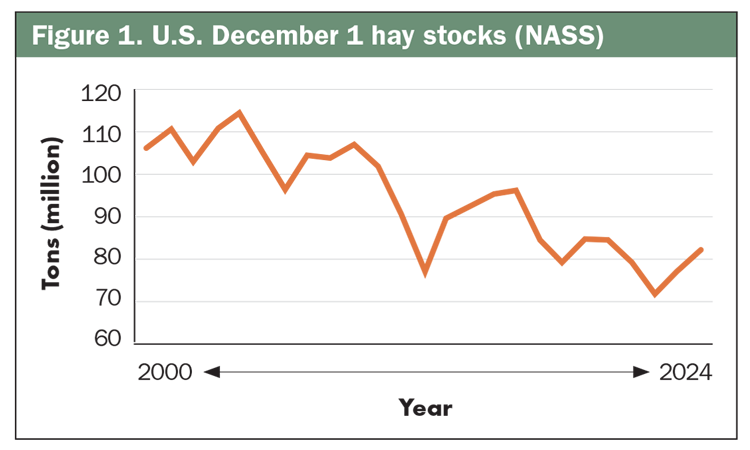
According to the USDA’s Crop Production Annual Summary released last month, the nation’s forage production appeared to have ended on an overall positive note in 2024. Despite lower acreage for all hay types, average hay yields were largely on the rise. Of course, year-over-year fluctuations existed for individual states, and these were likely in concert with the type of weather experienced in those regions.
Hay production: U.S. production of all dry hay types totaled 122.5 million tons last year, which was up over 3% from 2023. Minnesota had the biggest year-over-year improvement in dry hay production, up 65%. Texas also saw significant gains with a 37% boost, and New York had the third-greatest bump in dry hay production at 34%.
Eight states — Delaware, Florida, Kansas, North Dakota, Ohio, Rhode Island, Washington, and Wyoming — reported dry hay production reductions between 20% and 30%.
Total alfalfa dry hay production in the U.S. was pegged at 49.8 million tons in 2024, which was virtually unchanged from the previous year. Idaho was at the top with 3.9 million tons, followed by Nebraska (3.483 million tons), South Dakota (3.480 million tons), and Montana (3.2 million tons).
After posting the most dramatic year-over-year decline in 2023, Wisconsin saw a 75% improvement in total alfalfa dry hay production, up 1.3 million tons for a total of 3.03 million tons. Four other Midwestern states rounded out the best year-over-year production gains:
- Minnesota — up 867,000 tons
- Nebraska — up 593,000 tons
- Iowa — up 336,000 tons
- Missouri — up 301,000 tons
North Dakota had the biggest drop in alfalfa dry hay production, down 30%, or 768,000 tons. Significant declines in 2024 alfalfa dry hay production were also seen in:
- Kansas — down 705,000 tons
- Idaho — down 646,000 tons
- South Dakota — down 492,000 tons
- Washington — down 445,000 tons
Seventeen states report total alfalfa production considering all harvest methods (dry hay, haylage, and greenchop). Wisconsin captured the top spot in this category with 5.72 million tons produced in 2024. The former leader, Idaho, slid to second place with 4.43 million tons, putting up nearly 16% less alfalfa across all harvest methods last year. South Dakota maintained the third-place slot with 3.60 million tons, and Nebraska came in fourth with a final production total of 3.56 million tons.
Harvested hay acres: USDA posted the final 2024 harvested hay acreage (all types) at 49.4 million acres, which was down more than 6% from 2023. This estimate only includes acres that had at least one cutting harvested as dry hay.
Texas continued to climb the acreage ladder with slightly over 4.91 million dry hay acres in 2024, which was up 5% from 2023. The next highest dry hay acreage was found in Oklahoma at 3.36 million acres; however, this was roughly 18% less than the previous year. South Dakota came in third with 2.88 million dry hay acres, followed by Missouri at 2.85 million.
Narrowing the scope to alfalfa and alfalfa-grass mixtures, dry hay production of these types totaled 14.6 million acres. This was down 6.4%, or 992,000 acres, from 2023.
The top states for alfalfa dry hay acres harvested in 2024 were Montana (1.5 million), South Dakota (1.45 million), and Idaho and North Dakota (940,000 acres each).
On an individual basis, Oklahoma checked in with the greatest year-over-year improvement in dry alfalfa hay acres, up 85,000. The Sooner State was followed by Illinois with 80,000 more acres. Missouri and New York both gained 50,000 dry alfalfa hay acres in 2024.
The steepest drop in year-over-year dry alfalfa hay acres was seen in North Dakota, down 590,000 acres. Its downstairs neighbor, South Dakota, had the next largest decline of 240,000 acres. Dry alfalfa hay acres in Kansas fell by 155,000, and both Montana and Wyoming had 150,000 fewer acres.
Of the 17 states that reported alfalfa production data considering all harvest methods (dry hay, haylage, and greenchop), South Dakota maintained its top position with 1.48 million acres harvested despite simultaneously posting the single largest year-over-year decline of 270,000 acres. Wisconsin followed closely behind with 1.47 million acres of alfalfa harvested, and Idaho held on in third place with 1 million acres.
New alfalfa seedings: Across the country, new seedings of alfalfa and alfalfa-grass mixtures totaled 1.85 million acres in 2024. Wisconsin had the highest number of new seedings with 240,000 acres, which was up 30,000 acres from the previous year. Six other states dedicated more than 100,000 acres to new alfalfa seedings last year: Minnesota (130,000), Montana (125,000), Idaho (115,000), South Dakota (110,000), and Colorado and New York (both 100,000).
Hay yield: The average U.S. dry hay yield (for all types) leapt from 2.25 tons per acre in 2023 to 2.48 in 2024. Average yields specifically for alfalfa and alfalfa-grass mixtures were also on the up at 3.41 tons per acres compared to 3.19 the previous year.
Arizona and California dominated the average alfalfa yield category in 2024 with 7.3 and 6.6 tons per acre, respectively.
For the 17 states reporting all harvest methods of alfalfa (dry hay, haylage, and greenchop), alfalfa yields on a dry equivalent basis averaged 3.77 tons per acre in 2024, which was almost 6% higher than 2023. Of these select states, only three states had an average yield of less than 3 tons of dry-equivalent forage: Missouri (2.99 tons per acre), Kansas (2.75 tons per acre), and South Dakota (2.43 tons per acre).
Corn silage: Corn silage production in the U.S. was estimated at 123 million tons in 2024, which was down roughly 5% from 2023. Average corn silage yield was 20.2 tons per acre, up 0.1 ton per acre compared to the previous year; however, record-high corn silage yields were reported throughout the Corn Belt in Iowa, Illinois, and Indiana. Area harvested rang in at 6.1 million acres, down roughly 6% year-over-year.
Wisconsin led the pack with 14.6 million tons of corn silage produced in 2024; however, both acreage (730,000 acres) and yield (20 tons per acre) were down from the previous year. Idaho championed average corn silage yields with 30 tons per acre, followed by Arizona with 27 tons per acre.

Hay stocks: Also released last month was the USDA’s Crop Production report, which pegged December 1, 2024, hay stocks at about 81.5 million tons. That was up over 4.8 million tons, or 6.3%, from a year ago, putting December hay stocks at their highest level since 2020; however, they remain much lower than pre-2010 inventories.
Although individual states always vary in the total amount and direction of year-over-year hay inventory, the largest inventory reductions in the major-hay producing states did not have a clear pattern. Those include Arizona, which was down 29.3%; South Carolina, down 28.3%; Washington, down 26.7%; and Georgia, down 20.4%.
Many states with the most improved inventories experienced serious drought in 2023 but had better conditions in 2024. The greatest hay stocks gains were reported in New Mexico (172%), Minnesota (91.7%), Wisconsin (90.8%), and Mississippi (40.8%).
The boost in hay stocks was largely expected considering greater year-over-year hay production and fewer moisture concerns across much of the country. Hay exports continued to struggle, which also translates to more hay in storage. Overall, present-day inventories will continue to support depressed hay prices. Keep in mind that these inventory numbers do not account for hay stored as higher moisture chopped haylage or baleage. •
This article appeared in the February 2025 issue of Hay & Forage Grower on pages 30-31.
Not a subscriber? Click to get the print magazine.

